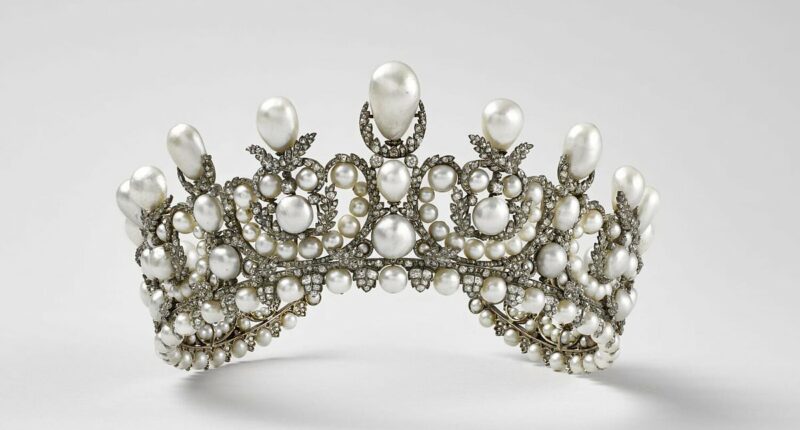Share this @internewscast.com
In a striking daylight heist, the Louvre was the target of one of the boldest jewel thefts in recent history.
Within a mere seven minutes, the world-renowned museum saw nine of its Imperial jewels vanish.
During the thieves’ hurried escape, the Crown of Empress Eugénie was dropped, shattering on impact with the ground.
However, eight invaluable and uninsured pieces were successfully whisked away in bags, as the robbers made their getaway on scooters. These jewels included treasures that once belonged to Eugénie, the final Empress of the French, as well as her predecessor, Empress Marie Louise, the second wife of Napoleon, and Queen Hortense of Holland, her mother-in-law.
It’s feared that these jewels, which have endured through revolutions and coups, may never be recovered after this audacious theft.
Here’s a look at the storied history of Empress Eugénie’s stolen jewels, which we may never have the chance to see again.
On 4th September 1870, two days after Napoleon III surrendered to Prussia, France was proclaimed a Republic and his wife, the last Empress of the French, prepared to flee the Tuileries Palace.

Empress Eugenie’s Bow Brooch, was one of the jewels that arrived in Manhattan. It had been bought for Mrs Caroline Astor, the Queen of New York Society

But many of Eugenie’s personal jewels, and all those belonging to the state, were left in Paris and 17 years later, after eight years of haggling and planning, catalysed by the Third Republic government’s fear that Bonapartists or Royalists would stage a coup, a far larger sale of ‘French Crown Jewels’ went ahead
Frantically Eugenie packed up many of her hundreds of pieces of jewellery into suitcases.
They would be taken by Princess Pauline Metternich, wife of the Austrian ambassador, and sent through the diplomatic post to London – where, in 1872, she would sell most of them at Christie’s.
But many of Eugenie’s personal jewels, and all those belonging to the state, were left in Paris and 17 years later, after eight years of haggling and planning, catalysed by the Third Republic government’s fear that Bonapartists or Royalists would stage a coup, a far larger sale of ‘French Crown Jewels’ went ahead.
So many jewels and regalia were put up for sale, that the Louvre’s Pavilion de Flore was taken over for 10 days, after all for a country that still boasts some of the best jewellers in the world and had a history of royals who commissioned designs on a daily basis (either Empress Eugenie, or her maids, are said to have visited the world’s oldest jeweller Mellerio on Rue de la Paix several times a week) – it is not surprising.
The sale attracted enormous international interest- jewellers arrived in Paris intent on purchasing these regal jewels, many on instruction from wealthy clients – and none more so than those of America’s Gilded Age.
Tiffany and Co, snapped up 24 of the 69 lots, took them back to New York with the jewels now set in custom made leather boxes, embossed with the words ‘Diamants de la Couronne’ and the French royal coat of arms in gold.
One of the most important and delicate pieces stolen from the Louvre on Sunday, was her beloved Pearl and Diamond Diadem.

One of the most important and delicate pieces stolen from the Louvre on Sunday, was Empress Eugenie’s beloved Pearl and Diamond Diadem

Police officers are in front of the Louvre Museum. The Louvre remains closed this Monday, a day after historic jewels were stolen from the world’s most-visited museum in a daring daylight heist
Commissioned by Napoleon III to celebrate his 1953 marriage to Eugenie, it was created by Lemonnier and set with almost 2000 diamonds and 212 round and pear shaped pearls – some of which had belonged to Napoleon I’s second wife, Empress Marie Louise. The iconic Imperial jewel was worn by Eugenie at several state occasions and in official portraits.
In 1855 she wore the diadem during a State Visit to the UK, when Queen Victoria created her husband a Knight of the Most Noble Order of the Garter. In the infamous 1887 sale, the diadem sold for 78000 francs and in 1890 given as a wedding present to the newly married Princess Margarethe of Thurn und Taxis, a great-granddaughter of King Louis-Philippe of the French. It was sold to the Louvre in 1992.
Empress Eugenie’s Bow Brooch, was one of the jewels that arrived in Manhattan. It had been bought for Mrs Caroline Astor, the Queen of New York Society, not by Tiffany’s but the jeweller Emile Schlesinger for 42,200 francs.
This sensational stomacher, which became famous in New York as ‘Mrs Astor’s Stomacher’ and is set with 2438 diamonds, was made by Francois Kramer for Empress Eugenie and first seen at Paris’s Universal Exhibition in 1855.
It was initially designed to be the buckle of a diamond belt and worn by the empress during a reception to celebrate the baptism of her only child, the Prince Imperial, in June 1856.
Eight years later she had the piece transformed into what it is today – and despite being called a brooch, is in fact a stomacher as it drapes down over the stomach. The jewel is designed with a huge and flamboyant bow of different cuts of diamonds, from which hang five long cascades of bezel-set round brilliants, and two lengthy tassels with sumptuous diamond ‘skirts’ suspended at the ends.

Empress Eugenie’s Bow Brooch, was one of the jewels that arrived in Manhattan. It had been bought for Mrs Caroline Astor, the Queen of New York Society
Mrs Astor, proud to be in possession of a French ‘Crown Jewel’, wore her diamond stomacher at innumerable events, until her death in 1908. The jewel remained in the Astor family until the 1990s and was next seen in 2001 at Sotheby’s London when jewellery magnate Ralph Esmerian bought the piece for £4m.
Only seven years later in April 2008, the jewel was put up for sale again – at Christie’s in New York. However, at the eleventh hour the sale, entitled Rare Jewels and Gemstones: The Eye of a Collector, was halted due to financial implications on Mr Esmerian’s part, disappointing a sales room with 100 bidders in person and another 150 on the phones.
Not long afterwards through a private sale, the Louvre paid over $10 million for the return of the Empress’s brooch, 121 years after it left its former home.
I can only dream that the jewels of the last Empress of the French, who fled to London in 1870 for Queen Victoria’s safety, will be discovered intact and can once again be a sparkling part of French Imperial history.
The Paris Connection, the fourth in the Jemima Fox heist series by Josie Goodbody will be published later this year









